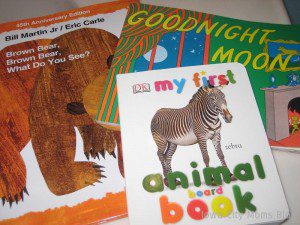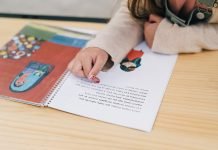Just as any new mom, I find it very fun to see all of the things my nine-month-old learns each day. Whether it is crawling or clapping, the proud look she has when completing a new skill is so darn cute!
As a pediatric speech-language pathologist, I see children with speech delays, disorders, syndromes, and other diagnoses each day. When I was pregnant, I wondered on more than one occasion if I would have a normally developing child. Although I appear to, I still worry that something will “pop up” as my child gets older. Will she stutter? Will she have any fine motor delays? These concerns are just a consequence of my profession.
Another consequence of working where I do is the number of people who, outside of work, tell me about their child and ask, “Is this normal?”
“My child does not say the /k/ sound yet…is this normal?”
“He isn’t saying any words yet at 14 months…is this normal?”
“My daughter has started to stutter a bit…is this normal?”
I have evaluations each week where I answer these questions, and I also hear it from friends, acquaintances, and even co-workers. Do I mind? Nope, not at all. Is it hard to answer at times? Definitely!
My goal for this post it to give all parents of young ones, especially toddlers, some ideas of activities you can do to encourage more language development in your child.
I do not want to cause anyone to worry, as there is a very WIDE RANGE OF NORMAL for children, especially under age two. However, we all want to do the best for our children, and I hope I can help you structure and add some language-building activities into your day.
Read Books Together Daily
When engaging in books together, keep in mind that you can deviate from the text. Try to match your child’s current language level and keep your utterances to one or two words by labeling the pictures (e.g. Bear eat). You can also ask your child to point to pictures (“Where’s the dog? Touch the dog.”). It is also fun to point to familiar pictures and say “What’s that?”, if your child is at that level. Classic children’s books such as “Brown Bear, Brown Bear,” feature repetition and familiar concepts. Also, a “first words” picture book is a good way to highlight common vocabulary like animals, foods, body parts, and clothing.
Sing Songs
Singing simple songs is a good low-pressure language activity that encourages participation even if child isn’t singing along. Good song choices include “Itsy Bitsy Spider” and “The Wheels on the Bus” which have accompanying gestures that you can model.
Activity Time
Set aside a little time each day (10-15 minutes 1-2x/day) for speech and language activities.
Sit on the floor across from your child so he/she can easily watch your face and mouth. Participate in basic, repetitive activities, such as taking turns rolling a ball back and forth or building a tower with blocks. Model basic language, such as “Block on,” or “More block,” as you build. If your child attempts to imitate you, offer praise (e.g. Yes, block! Block on!”). Attempt to repeat target vocabulary, such as “ball” and “block,” several times while playing.
Label Everyday Items
Daily activities, such as taking a bath and getting dressed, are fantastic times to boost vocabulary knowledge. Simply label the items around you while pointing to them or holding them up for the child to see. It helps to repeat the label multiple times, as children benefit from repetition. For example, when helping put socks on, say, “Socks. Socks on feet. Look, socks on.”
Play With Toys that Encourage Sound Imitation
Using animals is a great choice. Encourage imitation of animal sounds for slightly older toddlers. “The cow says ‘moo’. What does the cow say?” Don’t worry if you child doesn’t imitate right away. Also, don’t bombard your child with ten new animal sounds! Focus on one or two at a time and have fun with it!
Model Routines
Baby dolls and stuffed animals can be used for routines where the child gets to “take care” of the baby or animal. Use spoons and cups so that the baby can “eat” and “drink”. Use washcloth, towel, or small blanket so you can put the baby to bed. Model two-three word utterances such as “baby eat” or “more eat.”
Be Aware of Distractions
Many children have a hard time paying attention, let alone when there is background noise, such as the television or other people talking.
Keep it Short and Simple
Use language at the appropriate level of your child; for example, if your child is only speaking in single words, model language at the same level or slightly longer; for example, “dog” or “big dog.”
Create the Need to Talk
Make sure that talking is necessary for your little one. Although we are often able to anticipate or identify our child’s need or want (e.g. he/she needs more crackers), wait until your child tries to tell you!
Repetition, repetition, repetition!
Young children may pick up some words quickly but may need many, many models of others in order to learn!
All of these strategies are intuitive, but at the same time it can be easy to forget to do these things with your child. If you are late for work, it is easier to rush and dress your child while thinking about something else than to label each item and talk about what you are doing. That is OK! I can say from experience that it is easy to have a million other things to do and realize that there just isn’t time to read a book before bed (unless I want to read to a crying, over-tired baby!).
Again, there is a wide range of normal for children, and you don’t need to unnecessarily worry if your baby isn’t saying at least one word at age one, putting two words together at two, etc. However, keep in mind that all pediatric speech-language pathologists see many, many language delayed kiddos who just need a little “boost” in order to learn some new skills. If you have any concern, we are all here to help!
I hope this has been helpful for some of you. You daily routines and habits can make a world of difference in your child’s development!













Great post Lana! A great reminder for all Moms out there!